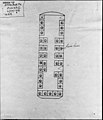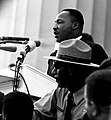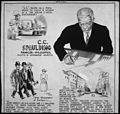The civil rights movement portal The civil rights movement was a social movement and campaign from 1954 to 1968 in the United States to abolish legalized racial segregation, discrimination, and disenfranchisement in the country. The movement had its origins in the Reconstruction era during the late 19th century and had its modern roots in the 1940s, although the movement made its largest legislative gains in the 1960s after years of direct actions and grassroots protests. The social movement's major nonviolent resistance and civil disobedience campaigns eventually secured new protections in federal law for the civil rights of all Americans. After the American Civil War and the subsequent abolition of slavery in the 1860s, the Reconstruction Amendments to the United States Constitution granted emancipation and constitutional rights of citizenship to all African Americans, most of whom had recently been enslaved. For a short period of time, African-American men voted and held political office, but as time went on Blacks were increasingly deprived of civil rights, often under the racist Jim Crow laws, and African Americans were subjected to discrimination and sustained violence by white supremacists in the South. Over the following century, various efforts were made by African Americans to secure their legal and civil rights, such as the civil rights movement (1865–1896) and the civil rights movement (1896–1954). The movement was characterized by nonviolent mass protests and civil disobedience following highly publicized events such as the lynching of Emmett Till. These included boycotts such as the Montgomery bus boycott, "sit-ins" in Greensboro and Nashville, a series of protests during the Birmingham campaign, and a march from Selma to Montgomery. At the culmination of a legal strategy pursued by African Americans, in 1954 the Supreme Court struck down the underpinnings of laws that had allowed racial segregation and discrimination to be legal in the United States as unconstitutional. The Warren Court made a series of landmark rulings against racist discrimination, including the separate but equal doctrine, such as Brown v. Board of Education (1954), Heart of Atlanta Motel, Inc. v. United States (1964), and Loving v. Virginia (1967) which banned segregation in public schools and public accommodations, and struck down all state laws banning interracial marriage. The rulings played a crucial role in bringing an end to the segregationist Jim Crow laws prevalent in the Southern states. In the 1960s, moderates in the movement worked with the United States Congress to achieve the passage of several significant pieces of federal legislation that authorized oversight and enforcement of civil rights laws. The Civil Rights Act of 1964 explicitly banned all discrimination based on race, including racial segregation in schools, businesses, and in public accommodations. The Voting Rights Act of 1965 restored and protected voting rights by authorizing federal oversight of registration and elections in areas with historic under-representation of minority voters. The Fair Housing Act of 1968 banned discrimination in the sale or rental of housing. (Full article...) Selected article -The 1964 Monson Motor Lodge protest was part of a series of events during the civil rights movement in the United States which occurred on June 18, 1964, at the Monson Motor Lodge in St. Augustine, Florida. The campaign between June and July 1964 was led by Robert Hayling, Martin Luther King Jr., Ralph Abernathy, Andrew Young, Hosea Williams, C. T. Vivian and Fred Shuttlesworth, among others. St. Augustine was chosen to be the next battleground against racial segregation on account of it being both highly racist yet also relying heavily on the northern tourism dollar. Furthermore, the city was due to celebrate its 400th anniversary the following year, which would heighten the campaign's profile even more. Nightly marches to the slave market were organized, which were regularly attacked and saw the marchers beaten. At the same time in the U.S. Senate, the civil rights bill was being filibustered. On June 10, this filibuster collapsed. The following day, King was arrested in St. Augustine. King had attempted to be served lunch at the Monson Motor Lodge, but the owner, James Brock—who was also the president of the St. Augustine Hotel, Motel, and Restaurant Owners Association—refused to serve him. King was arrested for trespass and jailed; while imprisoned, he wrote a letter to leading Jewish reformer, Rabbi Israel Dresner, urging him to recruit rabbis to come to St. Augustine and take part in the movement. This they did, and at another confrontation at the Monson, 17 rabbis were arrested on June 18. This was the largest mass arrest of rabbis in American history. At the same time, a group of black and white activists, protesters who had arrived from Albany, Georgia, J.T. Johnson, Brenda Darten, and Mamie Nell Ford, jumped into the Monson's swimming pool. Brock appeared to pour muriatic acid into the pool to burn the protesters. Photographs of this, and of a policeman jumping into the pool in everything but his shoes to arrest them, made headline news around the world. By now the Civil Rights Act had been passed, but St. Augustine businesses—particularly in the restaurant and culinary trades—were slow at desegregating. Eventually the courts forced Brock and his colleagues to integrate their businesses, and soon after he did, the Monson was firebombed by the Ku Klux Klan (KKK), who violently opposed desegregation. The state judge was unsympathetic to his predicament, however, feeling that Brock and his colleagues had brought the violence of the KKK upon themselves; they had taken advantage of it while it was in their favor, and could not stop it now that it was not. (Full article...)General imagesThe following are images from various civil rights movement-related articles on Wikipedia.
Related portalsWikiProjectsSelected biography -Elizabeth Ann Eckford (born October 4, 1941) is an American civil rights activist and one of the Little Rock Nine, a group of African American students who, in 1957, were the first black students ever to attend classes at the previously all-white Little Rock Central High School in Little Rock, Arkansas. The integration came as a result of the 1954 United States Supreme Court ruling Brown v. Board of Education. Eckford's public ordeal was captured by press photographers on the morning of September 4, 1957, after she was prevented from entering the school by the Arkansas National Guard. A dramatic snapshot by Will Counts of the Arkansas Democrat showed the young girl being followed and threatened by an angry white mob; this and other photos of the day's startling events were circulated around the US and the world by the press. Counts's image was the unanimous selection by the Pulitzer jury for a 1958 Pulitzer Prize, but since the story had earned then-rival Arkansas Gazette two other Pulitzer Prizes already, the Pulitzer board awarded the prize to another photographer for a pleasant photograph of a two-year-old boy in Washington, D.C. A different photo taken by Counts of Alex Wilson, a black reporter for the Memphis Tri-State Defender being beaten by the angry mob in Little Rock the same day, was chosen as the "News Picture of the Year" for 1957 by the National Press Photographers Association. This image by Counts prompted President Dwight D. Eisenhower to send federal troops to Little Rock. (Full article...)Selected image - During the Civil Rights March on Washington, D.C. — Leaders marching from the Washington Monument to the Lincoln Memorial, (August 28, 1963).
Did you know?
TopicsSubcategoriesThings to doAssociated WikimediaThe following Wikimedia Foundation sister projects provide more on this subject:
Discover Wikipedia using portals
|




















































